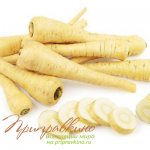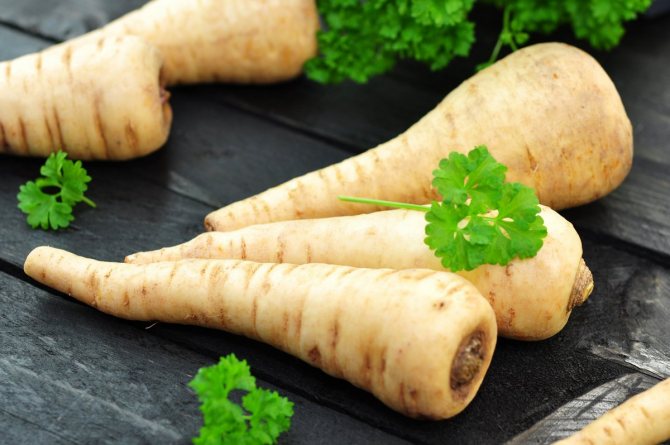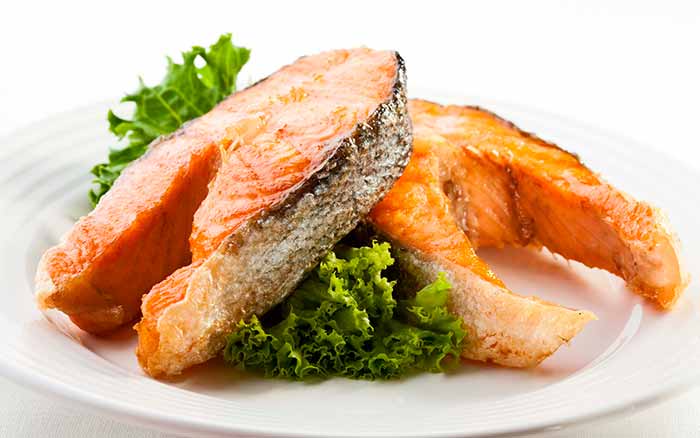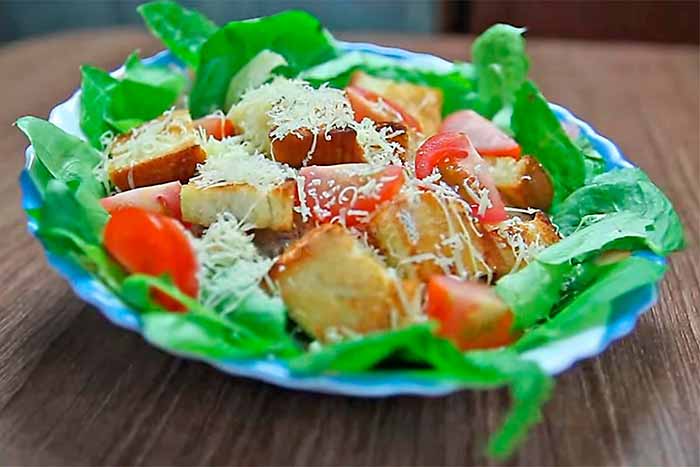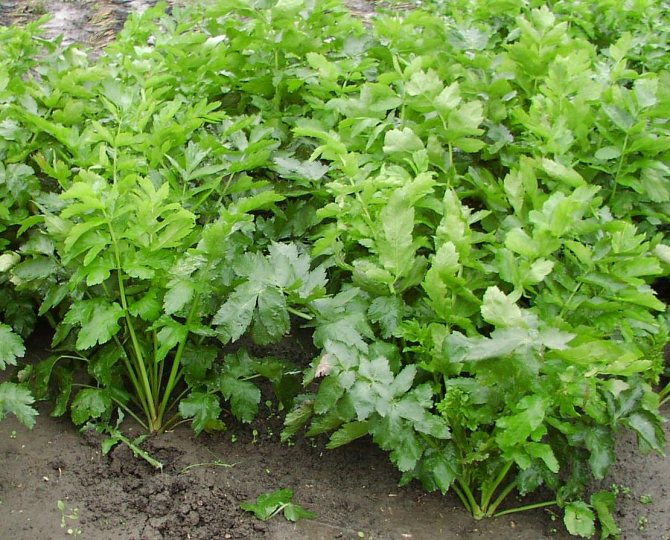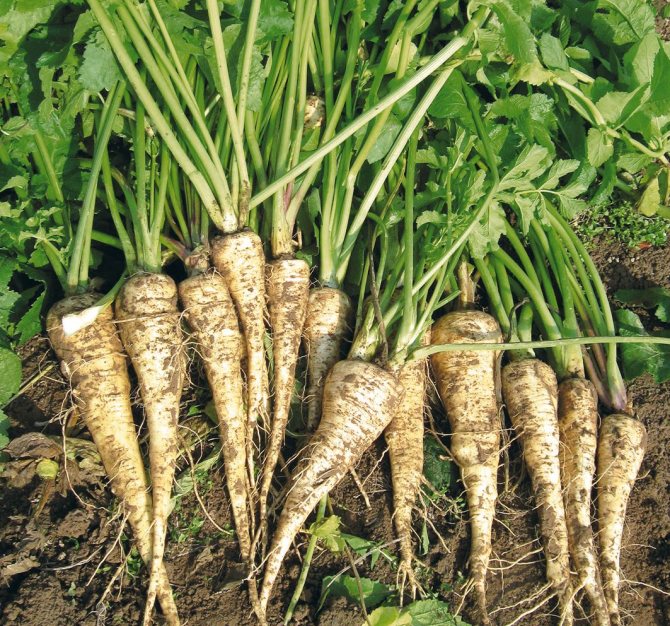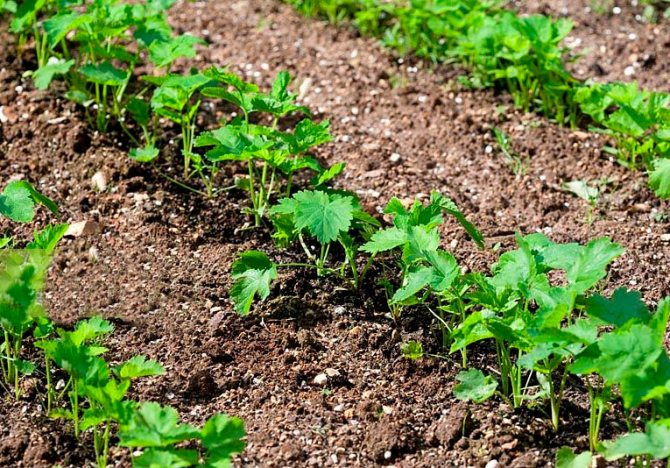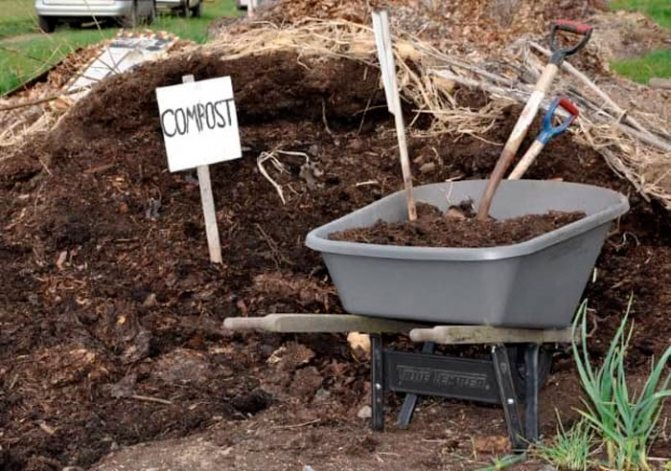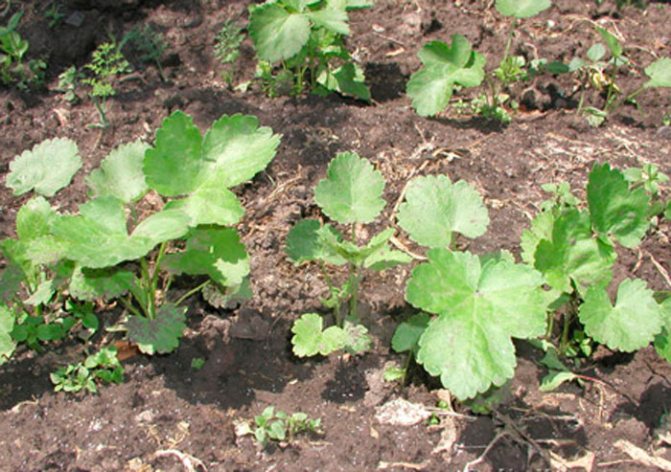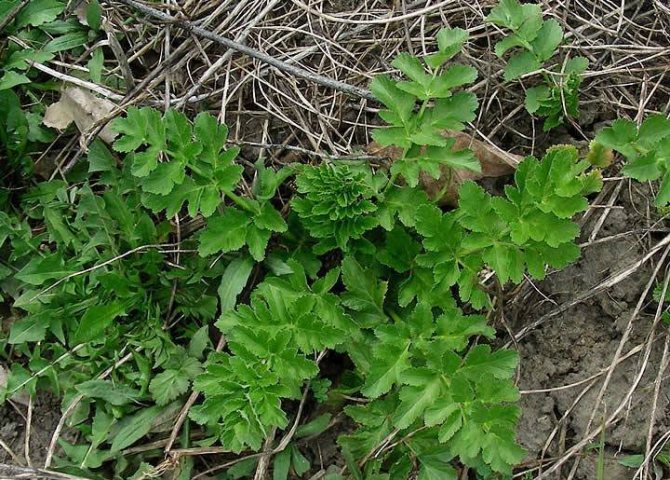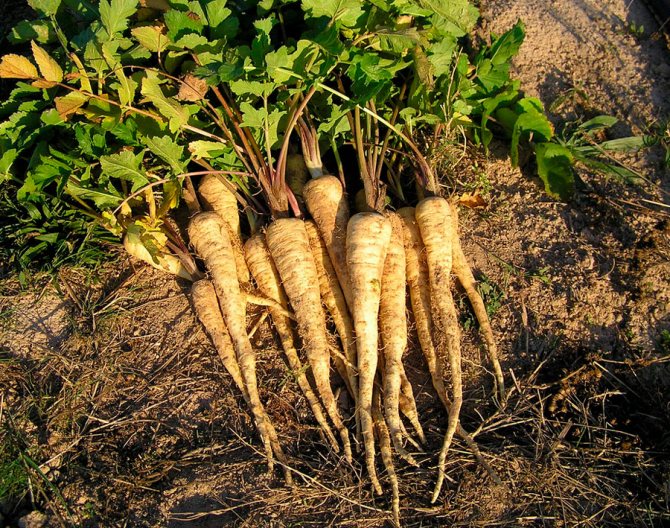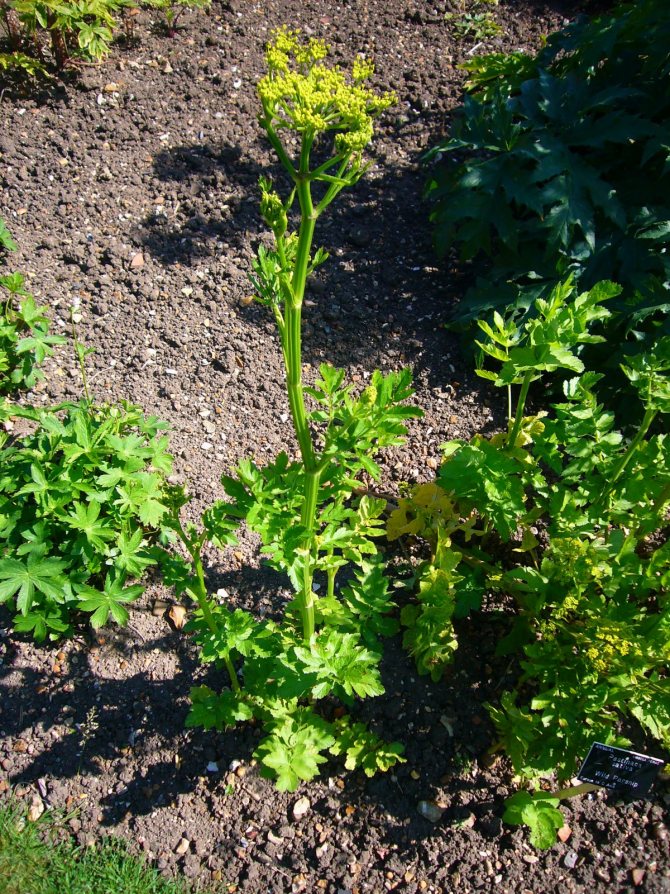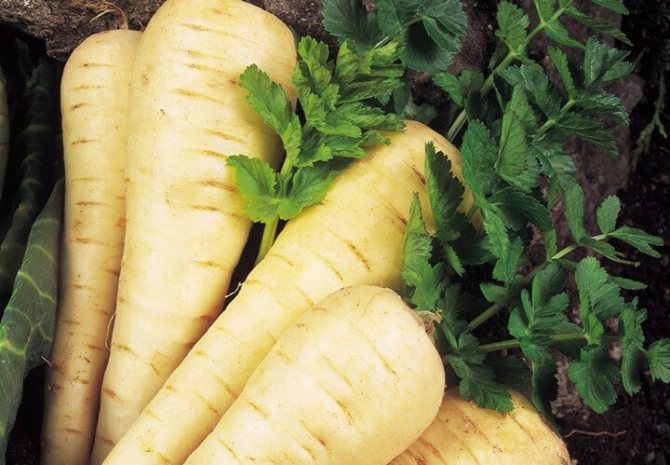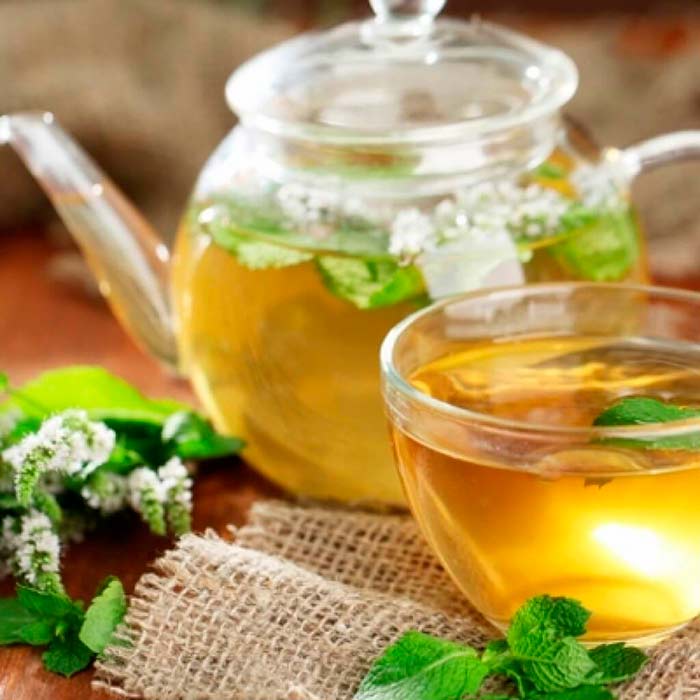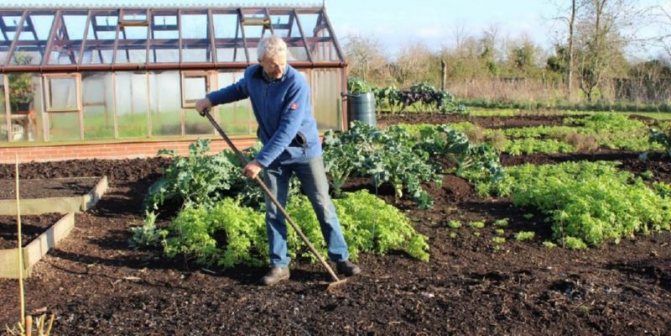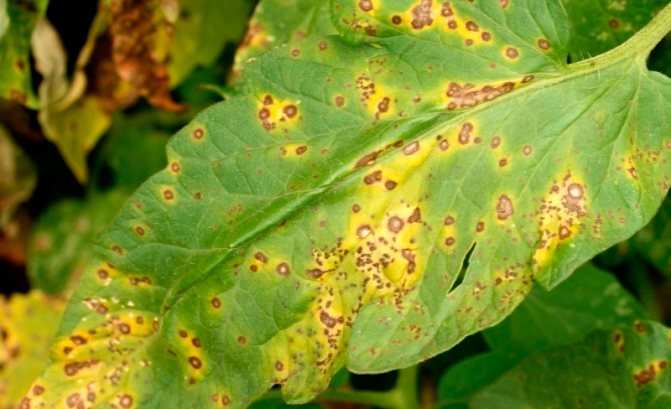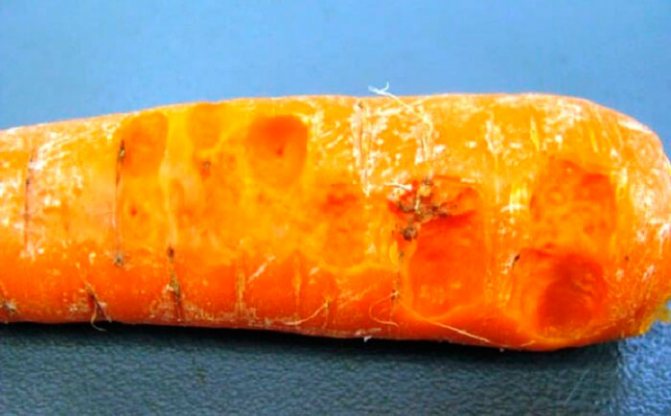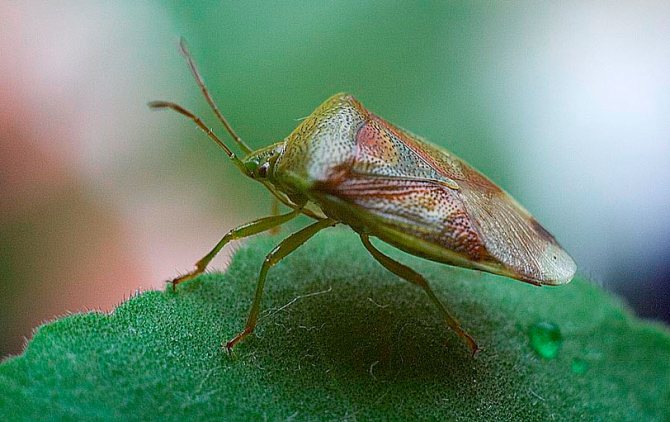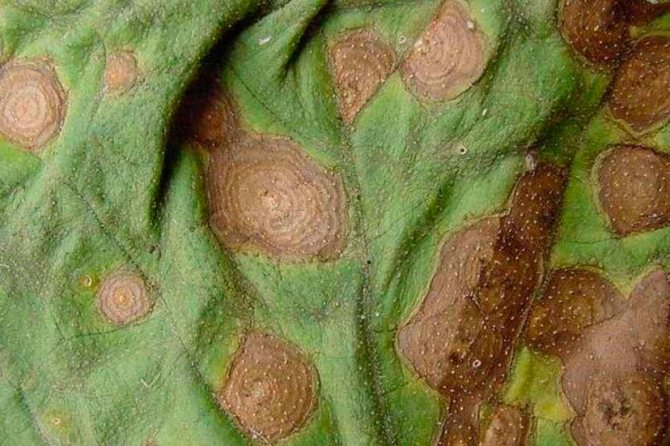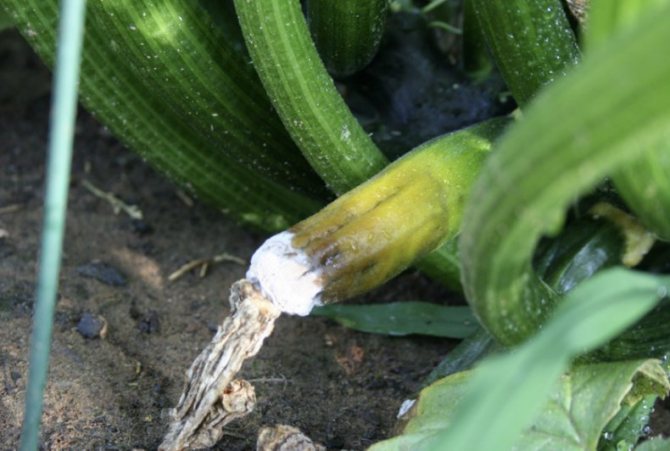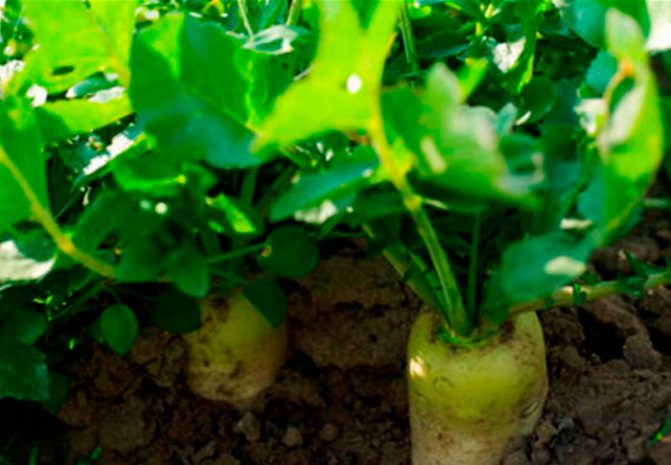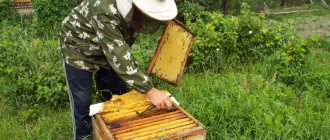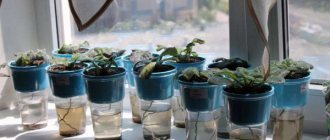What is parsnip (vegetable)?
Parsnip is a creamy, cone-shaped root vegetable from the same family as carrots, similar in appearance, just as sweet, but with a more complex earthy, nutty flavor. In cooking, it is used both as a vegetable and as a spice.
It looks like a thick white carrot, but despite the resemblance, it is not often eaten raw as a crunchy snack. Parsnips are added to stews, soups, stews and other dishes to which they impart a delicious nutty flavor.
If you buy a ready-made set of vegetables for making broth, then for sure there will be this root vegetable too.
Parsnips are also found as a main vegetable dish in European countries, especially in Great Britain.
What a parsnip vegetable looks like - photo
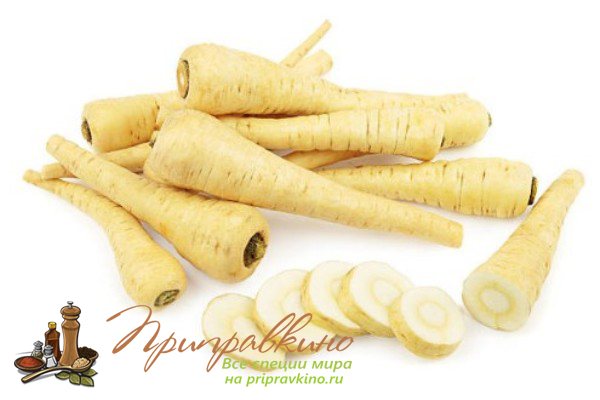
general description
Scientifically speaking, parsnips are a sweet, fleshy underground root vegetable of a perennial plant in the Pastinaca genus and the Apiaceae family - the same as carrots. They are even similar both in appearance and in growth characteristics, however, like other members of the Apiaceae family: parsley, celery, caraway seeds, dill, etc.
The official name of this vegetable: Pastinaca sativa - Parsnip ordinary or Sowing, synonyms - field borsch, tragus, popovnik, pastarnak.
It is a large plant with a rosette of trifoliate leaves. The root crop is large, white, conical.


Planting parsnips outdoors
When to plant parsnips outdoors
Parsnips are planted in open ground in mid-May, when the seedlings are 28-30 days old. At this time, as a rule, return frosts are already behind and the soil has already warmed up enough. Planting parsnips in the Moscow region is carried out at about the same time, adjusted for spring weather.
Soil for parsnips
Give your parsnips a well-sunlit area, although they can grow in partial shade. Moist peat, sandy loam and loamy soils with a neutral reaction are most suitable for parsnips. Acidic soils are contraindicated for parsnips, so they must be lime.
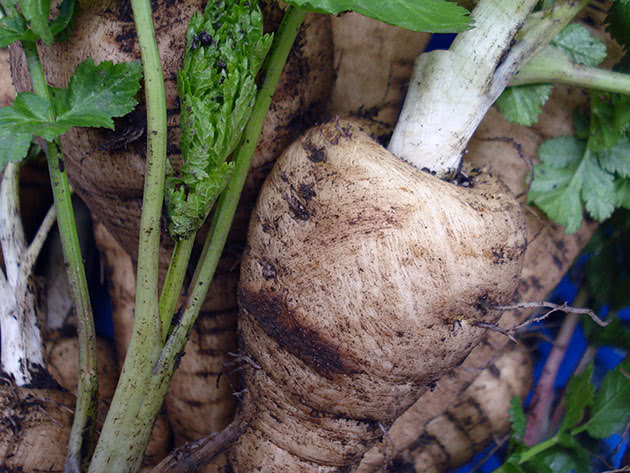

Try not to grow parsnips after plants such as carrots, parsley, celery, parsnips, and other root vegetables, as they all share common diseases and pests. Onions, cabbage, beets and potatoes are considered the best predecessors for parsnips, especially if fertilizers were applied for their planting - parsnips grow better on soils fertilized in advance, therefore, the site for it must be prepared in the fall: the soil is freed from weeds and, if the predecessors are not organic matter was introduced, they dig up a plot with rotted manure at the rate of half a bucket per m² of the plot.
In the spring, before planting seedlings in the ground, the soil is again dug up, leveled and high beds are formed.
How to plant parsnips outdoors
On the bed, holes are made at a distance of 10-12 cm from each other in a row and row spacings are not more than 40 cm. The depth of the holes should be such that the seedling can fit in it along with the peat pot. If you have planted parsnips in plastic pots, water the seedlings before replanting and carefully transfer them from pots to holes along with an earthen ball. Water the garden bed after planting.
- Sunflower: growing from seeds, planting in open ground and care
Planting parsnips before winter
Podzimny sowing of parsnips is carried out until mid-October in a prepared soil in advance (preferably from spring). Since the seeds of parsnips are large, they are sown in three pieces to a depth of 3-4 cm in holes located at a distance of 10-12 cm from each other with a row spacing of 40-45 cm. ... The emerging seedlings are thinned out in the same way as seedlings - the strongest sprout is left in the hole, and the rest are plucked out. We will tell you about how parsnips are taken care of in the next section.
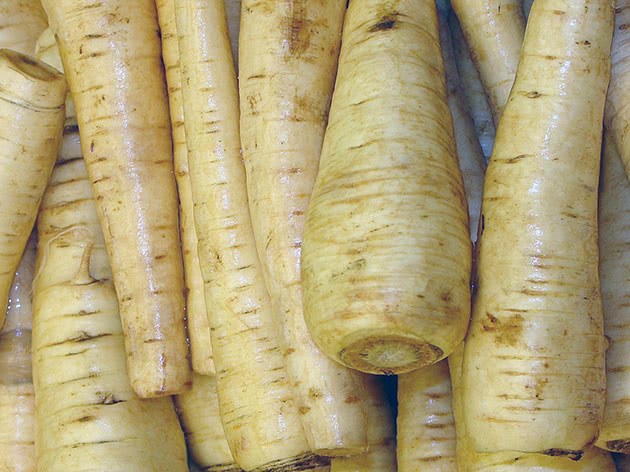

Where to buy and how to choose
Parsnips are sold all year round in the vegetable departments of supermarkets in large cities, as well as in farmers' markets in autumn.
Look for small to medium sized roots that are ivory and firm in texture. The parsnip should be fresh, fleshy, small (12-25 cm in length), without spots.
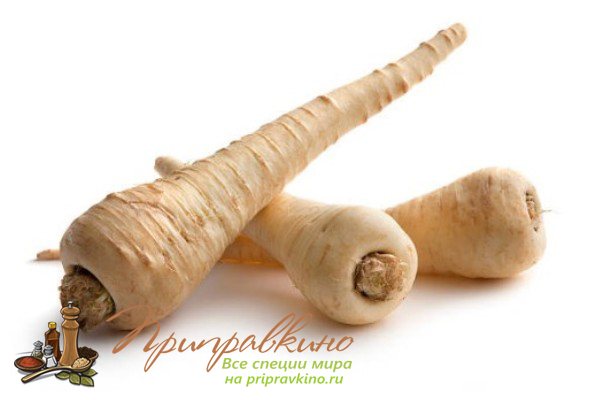

It can grow to enormous size, but large roots tend to be more fibrous and tough at the heart, while small ones are younger, sweeter and more delicate in flavor.
You shouldn't buy ripe parsnips as they are no longer as fragrant. Do not use soft, wrinkled, or damaged roots with many tiny, shaggy filaments at the end.
If the parsnip is with uncut greens, it should look fresh and not wilted. Cut it off before storing.
Planting and caring for parsnips
- Landing: sowing seeds in the ground - from mid to late April or before winter, at the end of October. Sowing seeds for seedlings - in the middle or at the end of March, planting seedlings in a garden bed - in mid-May.
- Lighting: bright sunlight or partial shade.
- The soil: wet, loamy, sandy loam or peaty, neutral reaction.
- Watering: when grown in moist soil, 4-5 abundant watering is enough in a drought, but watering is not needed in a season with normal rainfall.
- Top dressing: 3-4 times per season with mullein solution, ash infusion and liquid mineral complexes: a week after planting and again, three weeks later - with nitrogen fertilizer, and from the second half of July - with potassium and phosphorus fertilizers.
- Reproduction: seed.
- Pests: caraway moth, striped bugbug, field bug and aphids.
- Diseases: septoria, cercosporiasis, wet bacterial rot, black rot (or alternaria), white and gray rot of root crops.
Read more about growing parsnips below.
Chemical composition
Parsnips are rich in healthy phytonutrients, vitamins, minerals and fiber.
Nutritional value of fresh parsnips (Pastinaca sativa) per 100 g
| Name | number | Percentage of the daily value,% |
| Energy value (calorie content) | 75 Kcal | 4 |
| Carbohydrates | 17.99 g | 14 |
| Protein | 1.20 g | 2 |
| Fats | 0.30 g | 1 |
| Cellulose | 4.9 g | 13 |
| Folates | 67 mcg | 17 |
| Niacin | 0.700 mg | 4 |
| Pantothenic acid | 0.600 mg | 12 |
| Pyridoxine | 0.90 mg | 7 |
| Riboflavin | 0.050 mg | 4 |
| Thiamine | 0.090 mg | 7,5 |
| Vitamin C | 17 mg | 29 |
| Vitamin K | 22.5 mcg | 19 |
| Potassium | 375 mg | 8 |
| Calcium | 36 mg | 3,5 |
| Copper | 0.120 mg | 13 |
| Iron | 0.59 mg | 7.5 |
| Magnesium | 29 mg | 7 |
| Manganese | 0.560 mg | 24 |
| Phosphorus | 71 mg | 10 |
| Selenium | 1.8 μg | 3 |
| Zinc | 0.59 mg | 5 |
Pests and diseases of parsnip
Parsnip disease
Parsnip suffers from the same diseases as the rest of the umbrella family: septoria, cercosporosis, wet bacterial rot, black rot (or Alternaria), as well as white and gray rot of root crops.
Septoriosis is manifested by the formation of numerous medium-sized spots on the leaves of the plant without clear boundaries, which gradually darken and become brown-brown. Affected plants turn yellow and dry. Septoria progresses in cool weather against a background of high humidity. The penetration of infection occurs through the stomata.
Cercosporosis can be recognized by irregularly shaped yellowish or dirty-brown spots up to 6 mm in diameter that appear on the leaves and stems of the plant.With the development of the disease, the spots in the middle fade, and the border around them becomes darker. The edges of the affected leaves are raised and slightly curled. On the stems, elongated reddish-brown spots appear impressed. Sick plants lag behind in development, their leaves turn yellow and dry.


Wet bacterial rot is a widespread disease, especially in conditions of unstable temperatures and high humidity. It affects root crops both during storage and in the field. The disease begins with decay in the tail - first, dark watery-oily spots appear on the plant, then depressions with a rotting fetid mass are formed in their place, which flows out of the fruits in the form of mucus, due to which the spread of infection to other plants occurs very quickly.
Alternaria, or black rot, develops mainly already in storage: slightly depressed dark spots appear on the roots, on which a dark olive bloom forms in damp weather. In the section, the affected tissues are coal-black in color.
White rot (botrytis) and gray rot (sclerotinia) differ in the color of the plaque that forms on root crops. In case of white rot, the plaque is white, in the form of flakes with black sclerotia of the fungus, and gray rot covers the roots with a gray fluffy bloom. These diseases are most harmful in warm weather with high air humidity.
Parsnip processing
In order to prevent fungal diseases from infecting parsnips, we recommend you a set of measures, including:
- observance of crop rotation - parsnips can be returned to the site again no earlier than after 3-4 years;
- strict compliance of care measures with the rules of agricultural culture;
- thorough preparation of the site before planting, including the removal of the remnants of the previous culture from it;
- half-hour pre-sowing treatment of seeds in water of 50 ºC temperature, followed by rapid cooling and drying;
- proper storage of root crops.
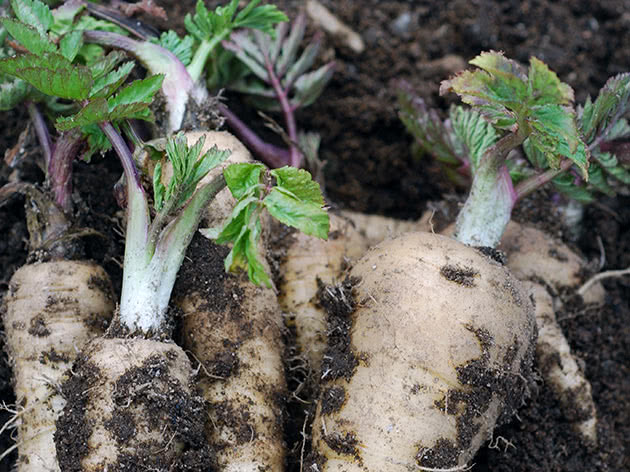

If, despite the strict fulfillment of all these conditions, a fungus has appeared on the site or in the storage, immediately remove the diseased specimens, and treat the healthy ones with one percent Bordeaux liquid, Fundazol or Topsin-M.
- Sunflower: growing from seeds, planting in open ground and care
Parsnip pests
Of the insects, the most dangerous for parsnips are the caraway moth, the striped shield bug, the field bug and aphids.
The caraway moth destroys the testes of the parsnip. Its caterpillars penetrate roots, stems and leaves and feed on their tissues. When flowering begins, they entangle the parsnip inflorescences with cobwebs, feeding on pedicels, flowers and seeds, after which they crawl back into the stem. In order to destroy the caterpillars, the plants are sprayed with a decoction of tomato tops: 3.5 kg of tops are crushed, 10 liters of boiling water are poured, insisted for two days, filtered and 40 g of grated laundry soap is added to the infusion.
The striped bush bug lives off the juice of young ovaries and buds, from which they die.
The field bug is a greenish-gray beetle reaching a length of 4 mm. Females lay eggs in plant tissue, and the larvae that emerge from them feed on the juice of the leaves and tops of parsnip shoots. In the puncture sites, the tissue dies, turns yellow and dries, and the toxic saliva of these pests leads to seed infertility. In a warm area, 3-4 generations of bugs can form during the growing season. You can destroy the field bug and striped shield bugs by Karbofos or Aktellik.
Aphids are one of the most dangerous and at the same time most prolific pests. She, like bugs, feeds on plant sap, from which they wither, deform and stop developing. In addition, she carries incurable viral diseases.You can fight it with folk methods, or you can use Antitlin, Biotlin, or the same means as in the fight against the Colorado potato beetle - Confidor, for its destruction, to destroy it.
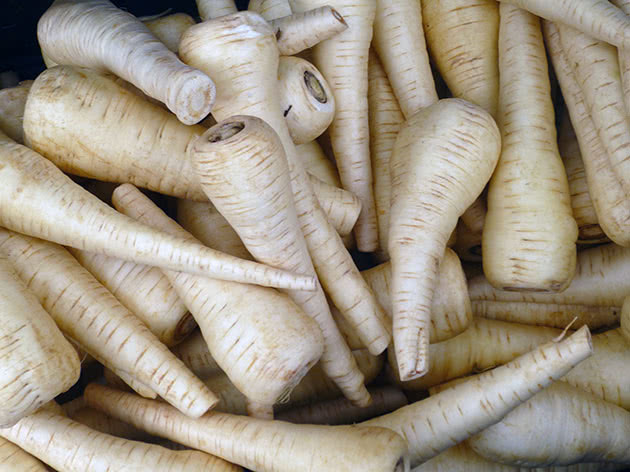

As a preventive measure, it is necessary to deal with weeds, and after harvesting, remove plant residues from the site and dig deep into the soil.
Health Benefits
The calorie content of 100 g of parsnips is 75 calories, which is about the same as in bananas and grapes. However, the sweet, juicy root contains no cholesterol.
This is one of the excellent sources of soluble and insoluble fiber: in 100 g - 4.9 mg, or 13% of the daily value. Dietary fiber in the diet helps to lower blood cholesterol levels and is beneficial for obesity and constipation.
Like carrots and other members of the Umbrella family, parsnips also contain many antioxidants, such as falcarinol, falcarindiol, and panaxadiol.
Several studies have shown that these compounds have anti-inflammatory, antifungal and anti-cancer properties, and provide protection against colon cancer and acute lymphoblastic leukemia.
Fresh root also contains a lot of vitamin C: about 17 mg, or 28% of the RDA. It is a powerful water-soluble antioxidant that supports healthy connective tissue and helps protect the body from disease by removing harmful free radicals.
Parsnips are rich in B vitamins such as folic acid, vitamin B-6 (pyridoxine), thiamine and pantothenic acid, as well as vitamins K and E.
It contains a good amount of minerals: iron, calcium, copper, potassium, manganese and phosphorus. For example, potassium is an important component of cells and body fluids that helps control heart rate and blood pressure.
Parsnips have many interesting health benefits:
- Improves heart health. Parsnips are high in potassium, which acts as a vasodilator and lowers blood pressure. Large amounts of folate (a form of folic acid) are ideal complements for this property, as it has a huge impact on maintaining a healthy cardiovascular system.
- Rich in fiber. High fiber content is closely associated with lower cholesterol levels (which further improve heart health) and a lower likelihood of developing diabetes. In addition, fiber, a key component of the digestive process, promotes the passage of food through the digestive tract, reduces constipation, and prevents other gastrointestinal problems.
- Reduces birth defects. Folate reduces birth defects in the neural tube in infants and normalizes metabolic processes associated with energy production and the nervous system.
- Promotes weight loss. In addition to being a low-calorie vegetable with a good amount of soluble vegetables, parsnips prevent the release of ghrelin, the "hunger" hormone. This significantly reduces the urge to snack between meals and thus helps to reduce weight.
- Boosts immunity. Parsnips are loaded with antioxidants, vitamins and organic compounds that protect the body from the toxic byproducts of our cellular metabolism. Vitamins C and E neutralize free radicals that cause chronic disease and even cancer. Vitamin C stimulates the production of white blood cells and also serves as a key element in collagen production.
Caring for parsnips
How to grow parsnips
Growing parsnips in the open field involves performing procedures that are well known to every gardener - watering, loosening the soil in the aisles, weeding and top dressing. Overall, parsnips are surprisingly unpretentious. The first loosening is carried out when seedlings appear or when you are convinced that the seedlings have started. Then the soil is loosened after each watering or rain.
Watering parsnips
Parsnips are hygrophilous and especially need water at the stage of root crop formation. Due to a lack of water, the leaves of the plant become pale, their growth slows down, and the parsnip can even release an arrow, while the roots crack, become rough, dry and fibrous. And from excess moisture parsnips can get sick with fungal diseases.
So how do you water a parsnip? If it grows in moist soil, 4-5 abundant watering in dry weather will be enough for it, but if it rains regularly in summer, then it is likely that you will not need to water the parsnip. After watering, it is convenient to loosen the soil in the area and remove weeds. But keep in mind that in hot, dry weather, parsnip leaves give off a caustic essential oil that causes burns, so try to work in the area after sunset or in the early morning.
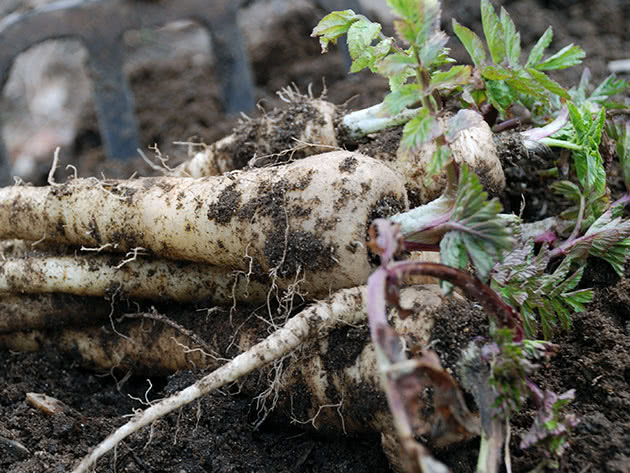

Feeding parsnips
During the growing season, parsnips are fed 3-4 times. How to fertilize parsnips? Fertilizers should be applied only in liquid form - mullein diluted with water in a ratio of 1:10, ash infusion or a solution of mineral fertilizers. A week or two after planting the seedlings, it is fed with nitrogen fertilizers, after another three weeks, nitrogen fertilization is repeated, and from the second half of July they switch to fertilizing parsnips with potassium and phosphorus fertilizers.
However, if you grow the plant in fertile soil, you can do without fertilizing, especially if fertilizers were applied during the preparation of the site.
Contraindications (harm)
The parsnip plant and its parts can cause allergic reactions in some sensitive individuals. Symptoms of the reaction include rashes and skin lesions, itching or burning sensation in the lips, mouth, and throat. In severe cases, there may be swelling of the lips, tongue and redness in the eyes, as well as difficulty breathing.
People who are allergic to birch pollen, such as walnuts, rice, carrots, and parsley, can cross-react with parsnips as well, so it is best for them to avoid it.
Types and varieties of parsnips
There are not so many types and varieties of parsnips in culture. According to the shape of the root crops, the types of parsnips are divided into round and long. Round varieties are easy to care for, and parsnips with long roots require well-developed soil. According to the ripening period, parsnip varieties are divided into early, ripening in 110-120 days from germination, mid-ripening, which will take from 120 to 140 days, and late, ripening in 140 or more days.
We offer you the best varieties of parsnips:
- Round - early ripening variety with a rounded-flattened conical root crop of grayish-white color weighing up to 170 g with a strong-smelling white pulp with a grayish-white core;
- Chef - also an early ripening variety, reaching ripeness in 95-105 days with a small but spreading leaf rosette and a conical-knotted creamy root vegetable weighing up to 140 g, rounded flattened at the base. The pulp is white with a grayish core;
- White stork - early variety with white smooth root vegetable weighing 90-110 g with white and juicy flesh of good taste. The variety has good keeping quality;
- Boris - early ripe high-yielding variety with cream-colored cone-shaped roots and aromatic white pulp of excellent taste;
- Hormone - an early ripe variety with white cone-shaped roots up to 22 cm long and up to 5 cm in diameter, completely submerged in the soil. The mass of fruits is 100-130 g, they are used as a side dish in fried and boiled form or as a seasoning;
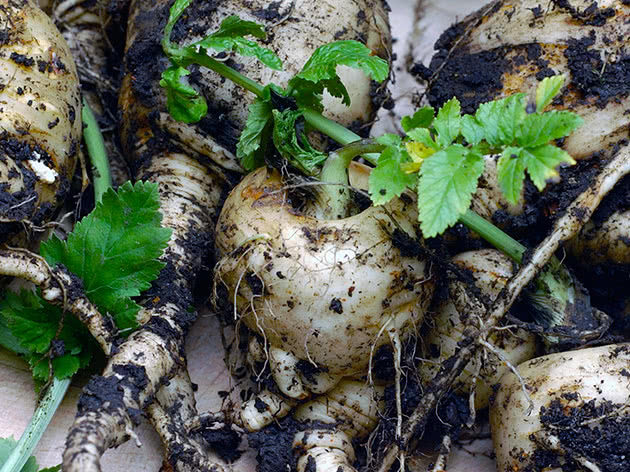

- Delicacy - mid-early, well-stored variety with rounded root crops weighing from 200 to 350 g and up to 8 cm long with aromatic white pulp with yellowish spots;
- Best of all - mid-early variety with a conical pointed white root vegetable weighing up to 200 g with white, tasty aromatic pulp;
- Petrik - a mid-season and high-yielding dietary variety for universal use, resistant to diseases, with a white conical root vegetable up to 35 cm long and up to 8 cm in diameter with a juicy, dense and aromatic gray-white pulp;
- Gladiator - mid-season fruitful hybrid with smooth cone-shaped white roots and white, aromatic, sugary pulp;
- Guernsey - a high-yielding late variety with well-stored root crops weighing up to 200 g and up to 25 cm long with white, aromatic, sweet pulp of excellent taste;
- Student - a late-ripening drought-resistant variety with a high yield, with white cone-shaped roots up to 30 cm long and weighing up to 160 g with white, very aromatic pulp of excellent taste.
In addition to those described, the Serdechko variety and the foreign varieties Hollow Crown, Contess, Javelin and Tender and Tru have proven themselves well in culture.
Parsnip-based preparations
A culture such as parsnip is also popular in the pharmaceutical field as a medicine. On the basis of an extract from this plant, some preparations are made:
- "Beroxan" - used to treat vitiligo and various other skin diseases, also helps with baldness.
- "Pastinacin" - tablets with analgesic effect, in addition, are used for coronary insufficiency.
- "Epigalin" is a drug for the treatment of hyperplasia, prostate, diseases of the ovaries, mammary glands and uterine endometrium.
All these drugs can only be prescribed by the attending physician. Their uncontrolled use will harm the body and lead to serious side effects.
Growing parsnips from seeds


Sowing
If you decide to grow parsnips on your site, then the first thing you need to do is sow. Of all the root crops, parsnip is the most hardy, and it would seem that its seeds can be sown directly into open soil in early spring, as soon as it warms up a little. However, gardeners prefer to grow this crop through seedlings, since the seeds contain a very large amount of essential oils, which is why they sprout for a long time.
Large seeds of this plant require pre-sowing preparation. To begin with, they are immersed in lukewarm water for 24 hours; it must be replaced immediately after it has cooled down. After that, they are treated with a growth stimulating agent, for example: Epin, Heteroauxin or Zircon. The prepared seeds are sown in peat pots, which are filled with a peat-based substrate. You can buy a soil mixture ready-made in a special store or make it yourself, for this you need to combine peat, perlite, garden soil and sand. Remember that the substrate must be loose and light. Before proceeding with sowing, the soil mixture is disinfected, for this it is sieved and spilled with freshly boiled water or steamed in an oven.
Fill the pots with moistened soil mixture, which is tamped so that it is at least 10 mm below the edge of the container, then 2 or 3 seeds are placed on its surface. From above it is necessary to cover them with a thin layer of the same soil mixture. Then the containers must be placed on a pallet, and they are covered with foil on top.
Seedling care


Until the seedlings appear, the crops should be regularly ventilated, for this, the shelter should be raised for 7–10 minutes once a day. It was already mentioned above that the seeds of this culture germinate rather poorly, because they contain a lot of essential oil, in this regard, the first seedlings should appear no earlier than half a month after sowing. When the first shoots appear, the shelter is removed, and the pots are moved to a well-lit place.
The seedlings of this culture need a sufficiently long daylight hours (about 14 hours) in this regard, if necessary, it should organize additional illumination.Water the seedlings as the top layer of the substrate dries out in containers. Remember that the water should not stagnate in the pots, because this can cause the plants to hurt or even die.
How to dive
It should be remembered that root crops react extremely negatively to picking, in this regard, it is recommended to sow them in individual containers, and not in general boxes. After the plants have 2 true leaf plates, it is necessary to choose the most powerful of all in the pot, and carefully pinch off the rest of the seedlings above the surface of the substrate. It is not recommended to pull out extra seedlings, as this can cause injury to the root system of a strong plant. About 1.5 weeks before transplanting parsnips into open soil, you should start hardening them. For this, the seedlings must be taken out into fresh air every day, while the duration of such a procedure is gradually increased.
Parsnips, how to cook, recipes
Raw parsnips are tasted - they are sweeter than carrots, spicy like parsley. The pulp is white, very firm, with a high dry matter content. When you fry it, it browns beautifully, you cannot distinguish it from potatoes in taste, appearance. You can't spoil the soup with parsnips either. In the filling, it is suitable for pies and stuffed peppers. Parsnips make an excellent filler for vegetable marinades and white sauce. For the winter, it can be dried by mixing it with other white roots - parsley and celery.
Here are some recipes I've tried.
Soup dressing
- 1 part parsnip
- 1 part carrot
- 1 part onion,
- 1 part red tomatoes
- 1 part salt.
Cut everything, mix well, stand for 1-2 days until the salt is completely dissolved and packaged. You can store it in the refrigerator without even freezing it.
Fried parsnips
Peel the root, cut into cubes, salt to taste, add onion rings and fry in vegetable oil for no longer than 8-10 minutes. Serve with sour cream.
Pasta sauce
Cook until soft one carrot, 1 onion, 200 g of parsnips. It turns out more delicious if vegetables are boiled in meat broth, but you can do without it. Remove from broth, mash in mashed potatoes. Dilute with the same broth, pour over the cooked pasta.
Stuffed pepper
Grate parsnips, carrots equally, add salt, finely chopped onions, leeks. Fry everything in sunflower oil. Combine with boiled rice, stir, fill with red peppers filling. Simmer for 10 minutes in sour apple juice or tomato.
Sauerkraut with parsnips
Chop the white cabbage, grind it with salt and add, as usual, the carrots, and besides them, the same amount of chopped parsnips. Tamp and ferment for ten days, piercing with a sharpened stick.
For 5 kg of cabbage - 300 g of carrots, 300 g of parsnips, 100 g of salt.
Vegetable stew in a skillet
Coarsely chop parsnips, carrots, onions. Fry everything in vegetable oil, salt, add chopped tomatoes, bring to readiness, season with grated garlic.
Application in cosmetology
Parsnip has nourishing, whitening properties and prevents the formation of wrinkles.
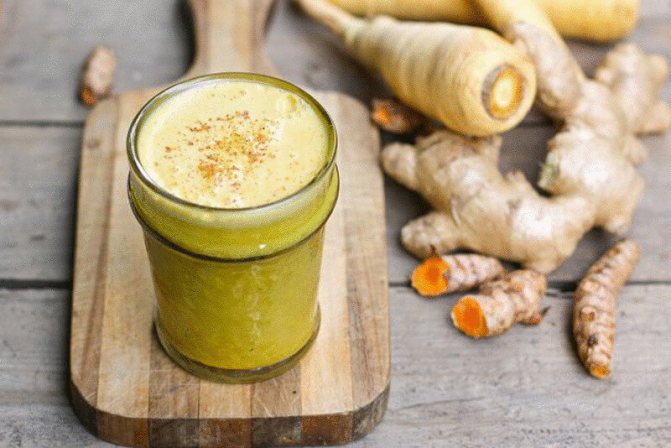

Root essential oil is used:
- with inflammatory processes;
- to combat cellulite, bruises under the eyes, acne;
- for quick healing of acne;
- to smooth out wrinkles;
- to strengthen hair, nail plates.
The leaves of the plant are used to treat vitiligo (inhibiting the spread of discolored spots), nesting baldness.
Parsnip preparations are most often used to stop diffuse baldness, which is widespread among women. For the treatment of hair loss, all parts of the plant are used: seeds, stems, roots, leaves. So, the juice of white carrots is rubbed into the roots to strengthen the follicles. It is best to perform this procedure in a bath when the pores are open.
Parsnip accelerates hair growth, makes the hair thicker.
Botanical description of parsnip
Common parsnip is a two-year-old spicy-flavoring and root vegetable crop with a height of 0.3 to 1.5-2.0 m. The appearance of its fruits is similar to carrots, but only white, hence the second name - "white root".
In the first year, the growing season of parsnips lasts 120-180 days, during which the plant forms a rosette of large dark green long-petiolized leaves with vertical growth and a fusiform root crop. The leaf blade of separately-pinnate rosette leaves forms 3-6 pairs of lateral lobes, glossy-smooth above, and fleecy below.
The root crop of parsnips is cone-shaped or rounded, the smooth surface of which is covered with convex buds, can reach up to 800 g. The flesh of the root crop is moderately dense, white or yellowish in color, it tastes like a very delicate carrot. The root system is pivotal, over time it deepens into the soil up to 1.5 m, which allows the plant to provide itself with the necessary moisture.
In the second year, the growing season of parsnips lasts 120-130 days, from the upper part of the root crop preserved after wintering, flower stalks are formed, up to 1 meter or more. They are hollow, slightly pubescent, ribbed, branched in the upper part, at the ends there are inflorescences in the form of complex umbrellas.
Parsnip is a cross-pollinated plant that crosses within the same species, including wild parsnips. With the onset of flowering, the root crop becomes inedible.
Parsnip flowers in inflorescences are small, yellow or yellow-orange with well-developed nectaries (good honey plant). Flowering lasts from July to late August. The opening of flowers in the umbrellas is gradual (from the marginal to the center), it takes a certain period of time, which affects the amicability of seed ripening. Two-seedlings are small, ripen in September. They are flattened in shape, rounded, of light brown shades, remain viable for 1-2 years.
In parsnips, the upper part of the root crop has a specific, slightly spicy, but pleasant taste and aroma (for an amateur).
Due to the high content of essential oils, parsnip seeds have a low germination rate - within 45-50%, which must be taken into account when seed reproduction.
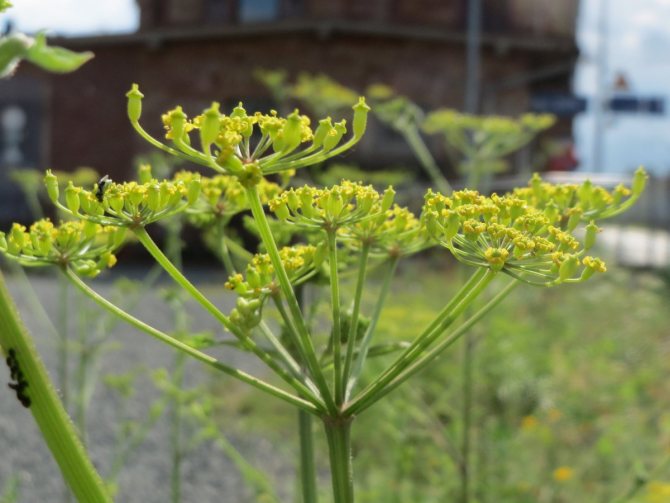

In the second year of the parsnip growing season, peduncles are formed from the upper part of the root crop preserved after wintering.
Cleaning and storage
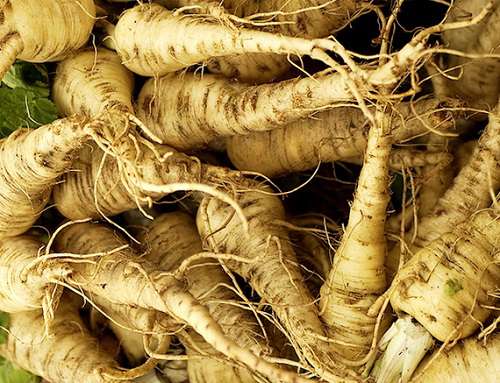

Parsnips are loyal to low temperatures, they can be removed "under the curtain" - before frost.
Small, short frosts will not damage the root vegetable.
To minimize damage when digging, it is better to use a pitchfork, not a shovel.
The tops are burning, you need gloves. Especially if the harvesting is early, at the beginning of the drying of the leaves - this is also practiced.
Storing parsnips is not easy. In a humid room, he is comfortable, but comfortable and pathogenic flora, it can cause disease.
When the air is dry, the parsnip withers, loses its juiciness and taste. The temperature must be maintained strictly, the range is small: 0 + 2 °.
Therefore, storage is easier for southerners - there you can leave the root crops undigged, they hibernate without any problems.
To dig in when needed to the table is such a storage technology.
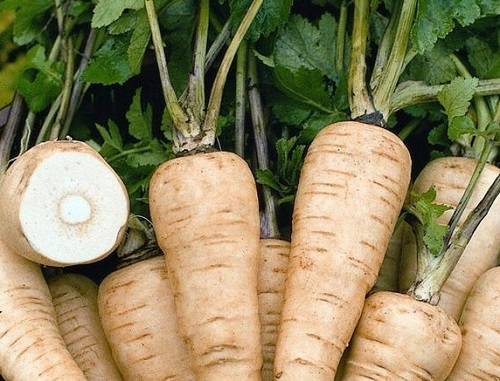

Not everyone grows a useful root crop.
Undeservedly pushed aside, pushed aside by other cultures, it is still waiting for the return of its former food fame.
If it is not yet provided for in your crop rotation, do not regret a little space, plant at least a couple of rows.
After that, you are unlikely to give up nutritious, tasty and healing parsnips: it will be registered on the site to your satisfaction.
See you soon, dear readers!

